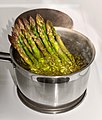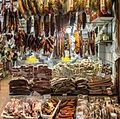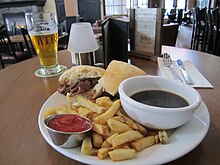Portal:Food
F o o d
A portal dedicated to food and foodways
Introduction
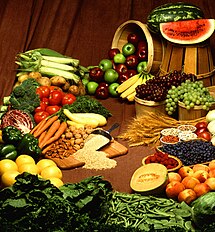
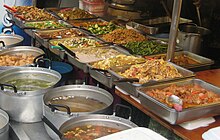
Food is any substance consumed by an organism for nutritional support. Food is usually of plant, animal, or fungal origin and contains essential nutrients such as carbohydrates, fats, proteins, vitamins, or minerals. The substance is ingested by an organism and assimilated by the organism's cells to provide energy, maintain life, or stimulate growth. Different species of animals have different feeding behaviours that satisfy the needs of their metabolisms and have evolved to fill a specific ecological niche within specific geographical contexts.
Omnivorous humans are highly adaptable and have adapted to obtain food in many different ecosystems. Humans generally use cooking to prepare food for consumption. The majority of the food energy required is supplied by the industrial food industry, which produces food through intensive agriculture and distributes it through complex food processing and food distribution systems. This system of conventional agriculture relies heavily on fossil fuels, which means that the food and agricultural systems are one of the major contributors to climate change, accounting for as much as 37% of total greenhouse gas emissions. (Full article...)
Cooking, also known as cookery or professionally as the culinary arts, is the art, science and craft of using heat to make food more palatable, digestible, nutritious, or safe. Cooking techniques and ingredients vary widely, from grilling food over an open fire, to using electric stoves, to baking in various types of ovens, reflecting local conditions. Cooking is an aspect of all human societies and a cultural universal.
Preparing food with heat or fire is an activity unique to humans. Archeological evidence of cooking fires from at least 300,000 years ago exists, but some estimate that humans started cooking up to 2 million years ago.
The expansion of agriculture, commerce, trade, and transportation between civilizations in different regions offered cooks many new ingredients. New inventions and technologies, such as the invention of pottery for holding and boiling of water, expanded cooking techniques. Some modern cooks apply advanced scientific techniques to food preparation to further enhance the flavor of the dish served. (Full article...)

The awarding of a flitch of bacon to married couples who can swear to not having regretted their marriage for a year and a day is an old tradition, the remnants of which still survive in Great Dunmow, Essex.
The Dunmow tradition originated at the nearby Little Dunmow, where it was practiced until the mid-eighteenth century. The origin of the custom is unknown, but according to tradition it was instituted by Robert Fitzwalter in the 13th century. The Dunmow flitch was referred to in Piers Plowman and by Chaucer, and seems to have already been widely-known at that time. A similar tradition practiced at Wychnor in Staffordshire can be traced back to the fourteenth century; related customs are also known from mainland Europe in Brittany and Vienna. (Full article...)
Selected article –
Popcorn (also called popped corn, popcorns, or pop-corn) is a variety of corn kernel which expands and puffs up when heated. The term also refers to the snack food produced by the expansion. It is one of the oldest snacks, with evidence of popcorn dating back thousands of years in the Americas. It is commonly eaten salted, sweetened, or with artificial flavorings.
A popcorn kernel's strong hull contains the seed's hard, starchy shell endosperm with 14–20% moisture, which turns to steam as the kernel is heated. Pressure from the steam continues to build until the hull ruptures, allowing the kernel to forcefully expand, to 20 to 50 times its original size, and then cool. (Full article...)
Selected cuisine -

Italian-American cuisine (Italian: cucina italoamericana) is a style of Italian cuisine adapted throughout the United States. Italian-American food has been shaped throughout history by various waves of immigrants and their descendants, called Italian Americans.
As immigrants from the different regions of Italy settled throughout the various regions of the United States, many brought with them a distinct regional Italian culinary tradition. Many of these foods and recipes developed into new favorites for the townspeople and later for Americans nationwide. (Full article...)
Selected ingredient –
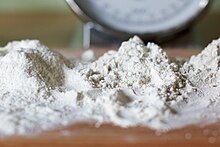
Flour is a powder made by grinding raw grains, roots, beans, nuts, or seeds. Flours are used to make many different foods. Cereal flour, particularly wheat flour, is the main ingredient of bread, which is a staple food for many cultures. Corn flour has been important in Mesoamerican cuisine since ancient times and remains a staple in the Americas. Rye flour is a constituent of bread in both Central Europe and Northern Europe.
Cereal flour consists either of the endosperm, germ, and bran together (whole-grain flour) or of the endosperm alone (refined flour). Meal is either differentiable from flour as having slightly coarser particle size (degree of comminution) or is synonymous with flour; the word is used both ways.Selected recipe –
A French dip sandwich, also known as a beef dip, is a hot sandwich consisting of thinly sliced roast beef (or, sometimes, other meats) on a "French roll" or baguette.
It is usually served plain but a popular variation is to top with provolone cheese, onions, and a dipping container of beef broth produced from the cooking process (termed au jus, "with juice"). Beef stock, a light beef gravy, or beef consommé is sometimes substituted. The sandwich is most commonly served with a cup on the side of the plate, into which the sandwich is dipped as it is eaten, although this is not how the sandwich was served when it was originally developed. (Full article...)

Ann H. Cook (fl. c. 1725 – c. 1760) was an English cookery book writer and innkeeper. In 1754 she published Professed Cookery, which went on to two further editions in her lifetime.
Living in Hexham, Northumberland, in 1739–1740 Cook and her husband John became embroiled in a feud with a well-connected local landowner, Sir Lancelot Allgood, following an argument over an invoice the Cooks had issued. Although they were later exonerated, Allgood continued his attack on them, forcing them to leave their inn and move. Their finances suffered and John was imprisoned for non-payment of debts. To earn money, Cook wrote The New System of Cookery in 1753, which was reissued as Professed Cookery in 1754. In the work, in addition to a range of recipes, she included a poem and an "Essay upon the Lady's Art of Cookery". This was an attack on Allgood's half-sister Hannah Glasse, who had published a best-selling cookery book, The Art of Cookery Made Plain and Easy, in 1747. (Full article...)
Selected image –
Selected biography –
Haddon Norman Salt (born 18 October 1928) is a British–American businessman, best known for founding the fast food chain H. Salt Esq. Fish & Chips and for acting as that company's brand ambassador, spokesman, and symbol. Salt followed his father and grandfather's careers, becoming a master fish cook and purveyor of fish and chips.
"I came over not simply to start a restaurant, but to introduce America to fish and chips, as grandiose as that dream sounds now". When Salt arrived in America in 1964, Britons ate an average of 100 pounds of fish per year, while Americans ate only 10 pounds per year. Salt said, "The way some of it is handled, I can see why".
Salt opened his first fish and chips shop in California in 1965. His business was acquired by the Kentucky Fried Chicken corporation in 1969. The sale made Salt the third largest stockholder in KFC, at the time the world's largest fast-food company.
KFC was not successful in the large-scale expansion of the H. Salt Esq. chain and sold the brand and business in 1972. Salt explained the brand's failure, saying "They started lowering the standards of the quality of the fish, and so the [sales] volumes of the restaurants went down and people stopped buying franchises, so that was the end of it. And it didn't grow anymore."
Salt left the company in 1972. (Full article...)
Did you know (auto-generated) –

- ... that food critic Grace Dent reviewed a Liverpool restaurant that served her rice pudding flavoured with a substance that is banned in the United States for its lethality?
- ... that a two-year-old food bank contributed 150 semi-trucks of supplies to relief efforts for Hurricane Katrina?
- ... that strawberry pie is one of the "red foods" traditionally served at Juneteenth celebrations?
- ... that within the Armenian Rite, it takes 40 days and more than 40 flowers, herbs, and spices to create the chrism known as myron?
- ... that environmental activist Nigel Savage created Hazon after googling "Jewish food movement" and receiving zero search results?
- ... that the operators of a Wisconsin radio station received unsolicited checks and food deliveries?
More did you know –
Related portals
Food topics
The following are topics relating to food
Categories
Food list articles
- See also: Lists of foods and Category:Lists of drinks
The following are some Food list articles on Wikipedia:

- American cheeses
- Appellation d'Origine Contrôlée cheeses
- Apple cultivars
- Bacon dishes
- Bacon substitutes
- Basil cultivars
- Breads
- Breakfast beverages
- Breakfast cereals
- Breakfast foods
- British cheeses
- Cakes
- Candies
- Cheeses
- Cheese soups
- Christmas dishes (list)
- Cocktails
- Cookies
- Dishes using coconut milk
- Diets
- Doughnut varieties
- Egg dishes
- Fermented soy products
- Food additives
- Food additives (Codex Alimentarius)
- Foods named after people
- French cheeses
- French dishes
- Fried dough foods
- Fruits
- List of hamburgers
- Herbs and spices
- Hors d'oeuvre
- Indian dishes
- Indian snack foods
- Indonesian dishes
- Italian dishes
- Japanese snacks
- Japanese dishes
- Jewish dishes
- Kebabs
- Korean beverages
- Mango cultivars
- Moroccan dishes
- Pasta
- Pastries
- Philippine snack food
- Pies, tarts and flans
- Poppy seed pastries and dishes
- Potato dishes
- Puddings
- Raw fish dishes
- Rice dishes
- Rolled foods
- Sauces
- Seafood
- Seeds
- Sandwiches
- Snack foods
- Soft drinks by country
- Soul foods and dishes
- Soups
- Stews
- Street foods
- Tapas
- Turkish dishes
- Twice-baked foods
- Vegetable oils
- Vegetables
- Vodkas
Things you can do
Related WikiProjects
| Parent project: WikiProject Food and Drink | |
| Child projects: | Task forces: (All inactive) |
|
|
| Related projects: | |
New articles
Rules | Match log | Results page (for watching) | Last updated: 2025-01-26 19:16 (UTC)
Note: The list display can now be customized by each user. See List display personalization for details.
- The Red Carpets (edit | talk | history | links | watch | logs | tools) by MaybeItsBecauseImALondoner (talk · contribs · new pages (81)) started on 2025-01-25, score: 10
- Mrs Crosby's (edit | talk | history | links | watch | logs | tools) by Surtsicna (talk · contribs · new pages (131)) started on 2025-01-25, score: 10
- Tanya Steel (edit | talk | history | links | watch | logs | tools) by KDuryea (talk · contribs · new pages (1)) started on 2025-01-24, score: 10
- Basque cheesecake (edit | talk | history | links | watch | logs | tools) by Andrew6111 (talk · contribs · new pages (3)) started on 2025-01-24, score: 40
- Rainbow Robotics (edit | talk | history | links | watch | logs | tools) by LandAndTree (talk · contribs · new pages (44)) started on 2025-01-24, score: 10
- Grain Belt Brewery (edit | talk | history | links | watch | logs | tools) by Darth Stabro (talk · contribs · new pages (18)) started on 2025-01-24, score: 10
- Zesta (edit | talk | history | links | watch | logs | tools) by DownTownRich (talk · contribs · new pages (1)) started on 2025-01-23, score: 20
- Grain Belt Beer Sign (edit | talk | history | links | watch | logs | tools) by Darth Stabro (talk · contribs · new pages (18)) started on 2025-01-22, score: 10
- Wenheyou (edit | talk | history | links | watch | logs | tools) by Underbar dk (talk · contribs · new pages (12)) started on 2025-01-23, score: 20
- Whole food (edit | talk | history | links | watch | logs | tools) by Wbm1058 (talk · contribs · new pages (16)) started on 2025-01-22, score: 10
- Nut (food) (edit | talk | history | links | watch | logs | tools) by AlmostReadytoFly (talk · contribs · new pages (1)) started on 2025-01-22, score: 20
- Tomodachiga Yatteru Cafe (edit | talk | history | links | watch | logs | tools) by 狄の用務員 (talk · contribs · new pages (3)) started on 2025-01-21, score: 10
- Joseph Knight (vegetarian) (edit | talk | history | links | watch | logs | tools) by Throughthemind (talk · contribs · new pages (15)) started on 2025-01-20, score: 10
- Pizza in Brazil (edit | talk | history | links | watch | logs | tools) by Avelludo (talk · contribs · new pages (2)) started on 2025-01-12, score: 20
- Mellow Bird's (edit | talk | history | links | watch | logs | tools) by PerfidiousSnatch (talk · contribs · new pages (3)) started on 2025-01-21, score: 10
- Maskurolhi (edit | talk | history | links | watch | logs | tools) by Drew Stanley (talk · contribs · new pages (2)) started on 2025-01-20, score: 10
- Jungle Bird (edit | talk | history | links | watch | logs | tools) by BanjoZebra (talk · contribs · new pages (3)) started on 2025-01-20, score: 30
- Yazdi coffee (edit | talk | history | links | watch | logs | tools) by Hounaam (talk · contribs · new pages (7)) started on 2025-01-20, score: 20
- Grand Prince Uian (1398) (edit | talk | history | links | watch | logs | tools) by Mohammad bahrami cyrus (talk · contribs · new pages (1)) started on 2025-01-19, score: 10
- James Watt (entrepreneur) (edit | talk | history | links | watch | logs | tools) by Aadamwaheed (talk · contribs · new pages (3)) started on 2025-01-18, score: 10
- Ichimura at Uchū (edit | talk | history | links | watch | logs | tools) by KoRoBeNiKi (talk · contribs · new pages (1)) started on 2025-01-19, score: 10
- Cassie Yeung (edit | talk | history | links | watch | logs | tools) by Willthacheerleader18 (talk · contribs · new pages (27)) started on 2025-01-19, score: 10
- Still Life with Apples and Oranges (edit | talk | history | links | watch | logs | tools) by Staticshakedown (talk · contribs · new pages (5)) started on 2025-01-18, score: 10
- Gordon House, Ham (edit | talk | history | links | watch | logs | tools) by AndyScott (talk · contribs · new pages (1)) started on 2025-01-18, score: 10
- Torta del Chavo (edit | talk | history | links | watch | logs | tools) by Muldoonsamuel55 (talk · contribs · new pages (1)) started on 2025-01-18, score: 30
- Slavonian honey (edit | talk | history | links | watch | logs | tools) by Mudroslov (talk · contribs · new pages (2)) started on 2025-01-17, score: 10
- Dinner Party (The Ren & Stimpy Show) (edit | talk | history | links | watch | logs | tools) by MimirIsSmart (talk · contribs · new pages (49)) started on 2025-01-16, score: 20
- Erin Jeanne McDowell (edit | talk | history | links | watch | logs | tools) by Samsmachado (talk · contribs · new pages (3)) started on 2025-01-15, score: 10
- Santuḷā (edit | talk | history | links | watch | logs | tools) by Adicraze (talk · contribs · new pages (1)) started on 2025-01-11, score: 10
- Yoajung (edit | talk | history | links | watch | logs | tools) by Seefooddiet (talk · contribs · new pages (18)) started on 2025-01-15, score: 20
- Stanley Green (edit | talk | history | links | watch | logs | tools) by Jlwoodwa (talk · contribs · new pages (59)) started on 2025-01-15, score: 10
- Lukken (edit | talk | history | links | watch | logs | tools) by Arbitrarily0 (talk · contribs · new pages (60)) started on 2025-01-15, score: 10
- Bevertainer (edit | talk | history | links | watch | logs | tools) by Eric Carpenter (talk · contribs · new pages (23)) started on 2025-01-14, score: 10
- Laura Theodore (edit | talk | history | links | watch | logs | tools) by Thriley (talk · contribs · new pages (81)) started on 2025-01-13, score: 10
- St Pierre's Sushi (edit | talk | history | links | watch | logs | tools) by Andykatib (talk · contribs · new pages (7)) started on 2025-01-13, score: 20
- Foreign aid to Afghanistan (edit | talk | history | links | watch | logs | tools) by Arbeiten8 (talk · contribs · new pages (51)) started on 2025-01-12, score: 10
- International Villager (edit | talk | history | links | watch | logs | tools) by UNIVERSALLORD77 (talk · contribs · new pages (1)) started on 2025-01-12, score: 10
- Rachel Ama (edit | talk | history | links | watch | logs | tools) by Starklinson (talk · contribs · new pages (15)) started on 2025-01-12, score: 10
- Zu (beverage) (edit | talk | history | links | watch | logs | tools) by Mmis325 (talk · contribs · new pages (30)) started on 2025-01-12, score: 20
- 2024 Bengaluru cafe bombing (edit | talk | history | links | watch | logs | tools) by XTheBedrockX (talk · contribs · new pages (204)) started on 2025-01-12, score: 10
- List of meat and potato dishes (edit | talk | history | links | watch | logs | tools) by Valereee (talk · contribs · new pages (4)) started on 2025-01-12, score: 30
Associated Wikimedia
The following Wikimedia Foundation sister projects provide more on this subject:
-
Commons
Free media repository -
Wikibooks
Free textbooks and manuals -
Wikidata
Free knowledge base -
Wikinews
Free-content news -
Wikiquote
Collection of quotations -
Wikisource
Free-content library -
Wikiversity
Free learning tools -
Wiktionary
Dictionary and thesaurus


















